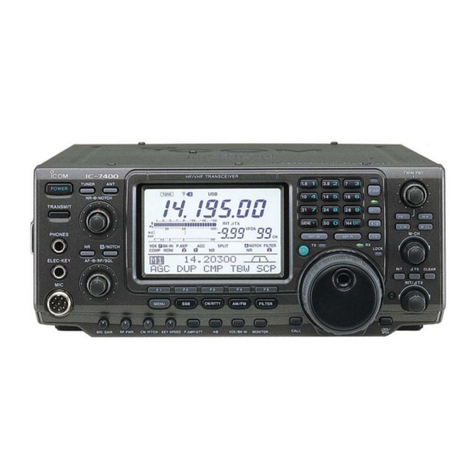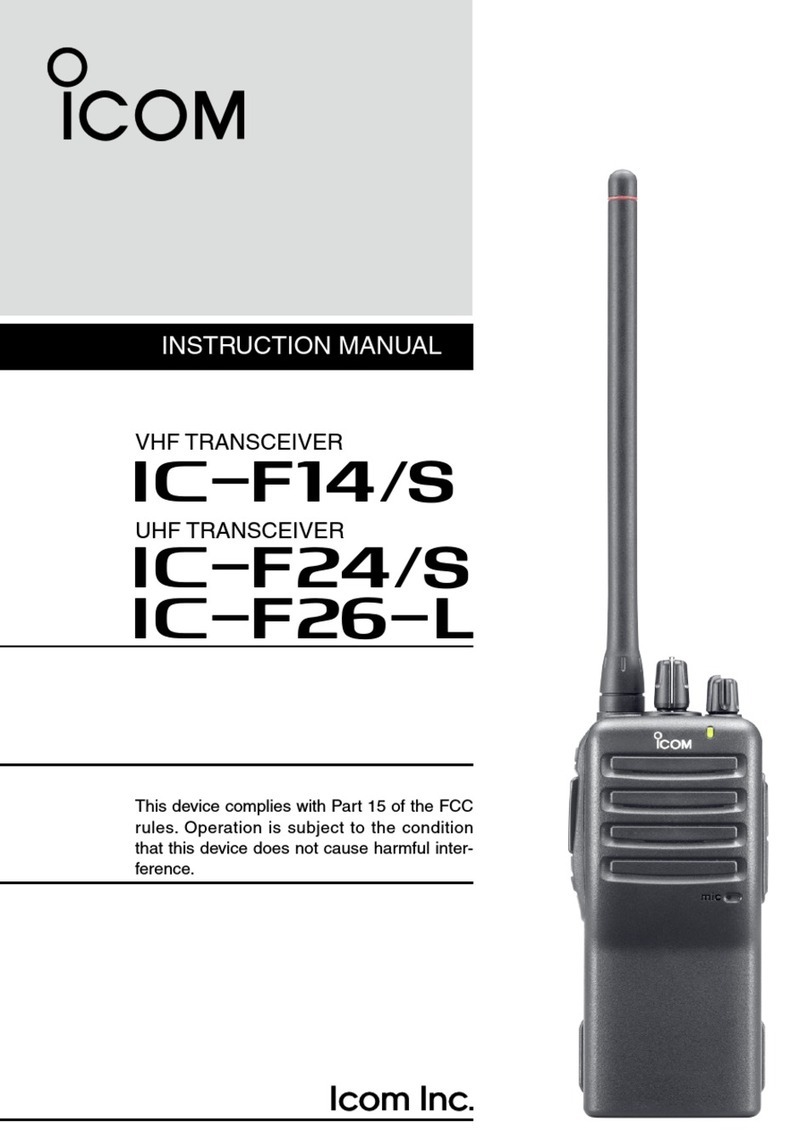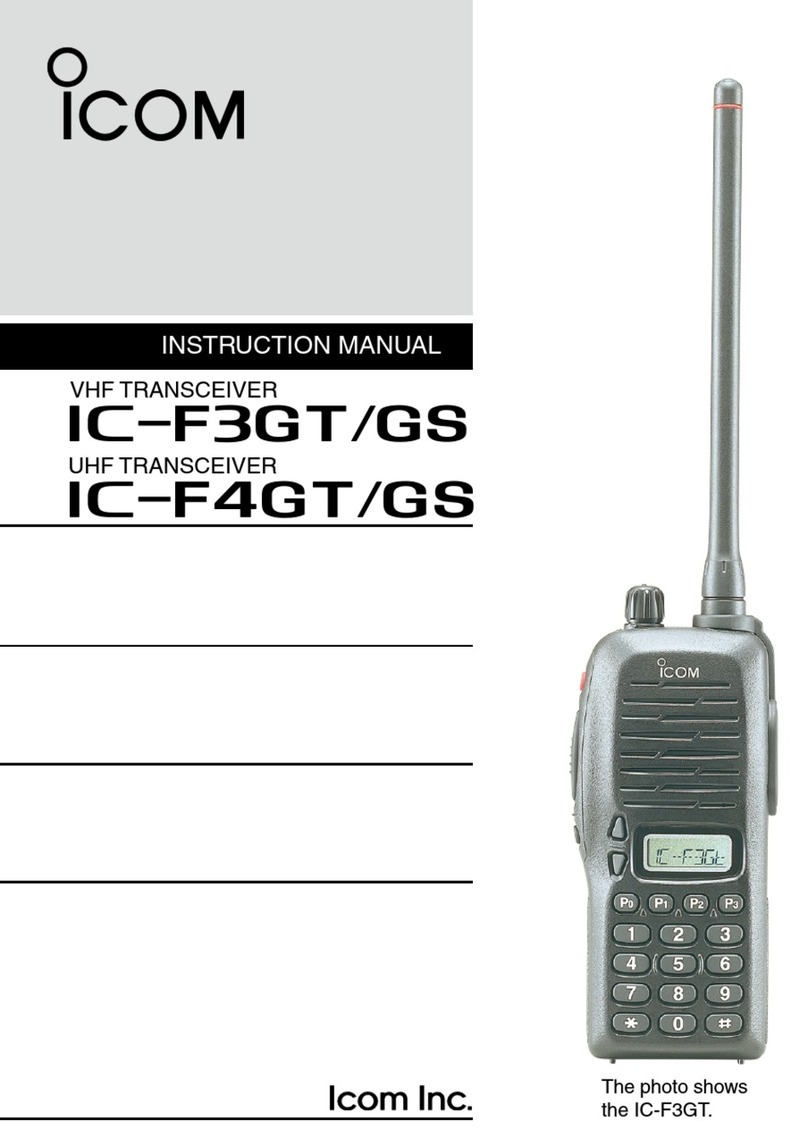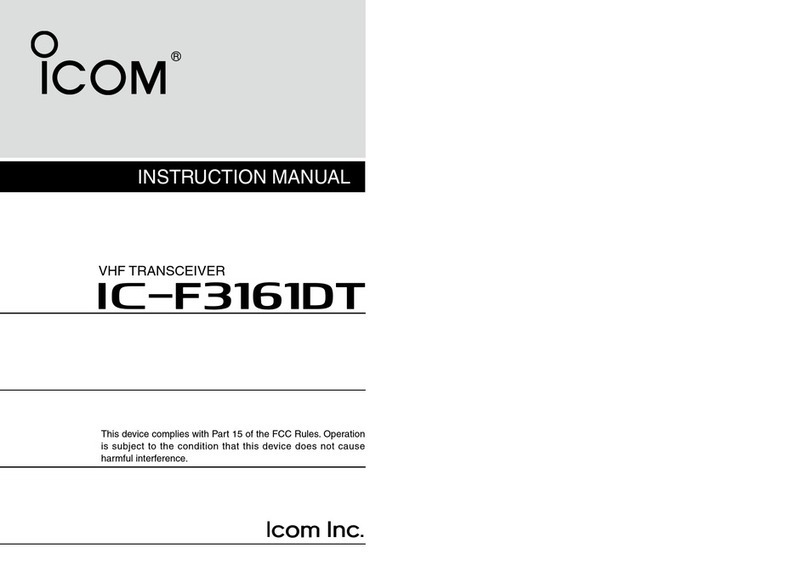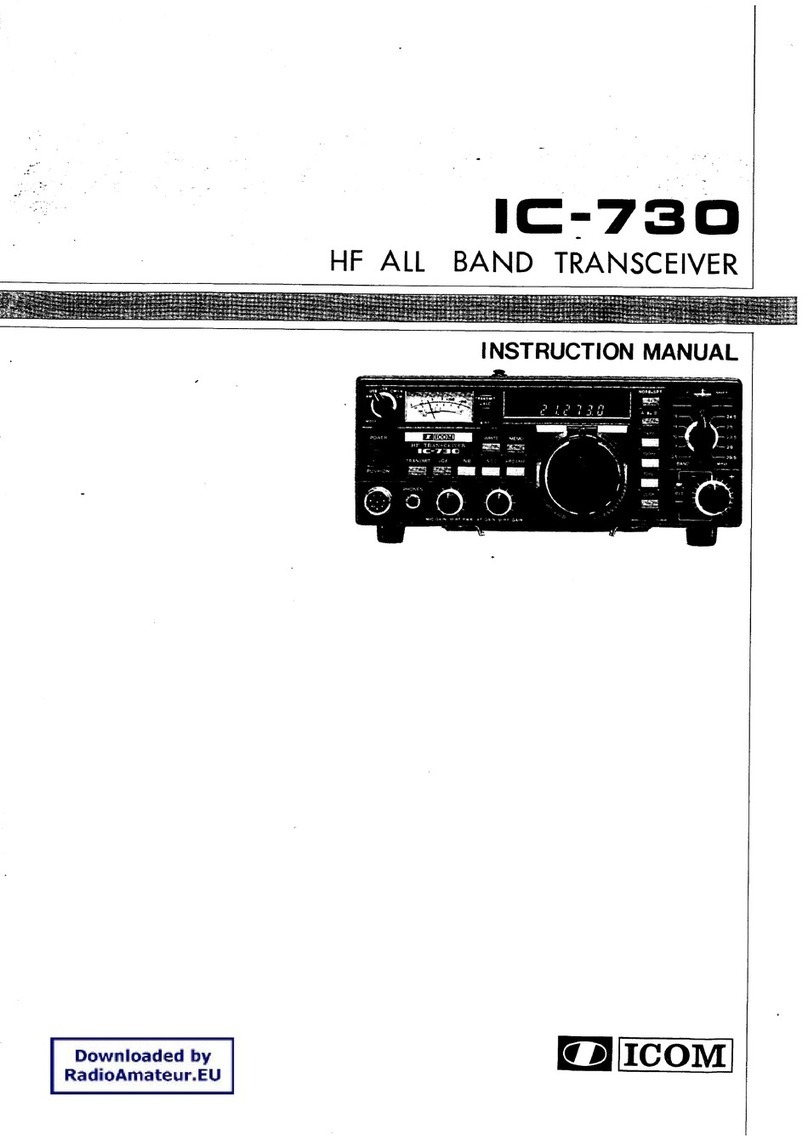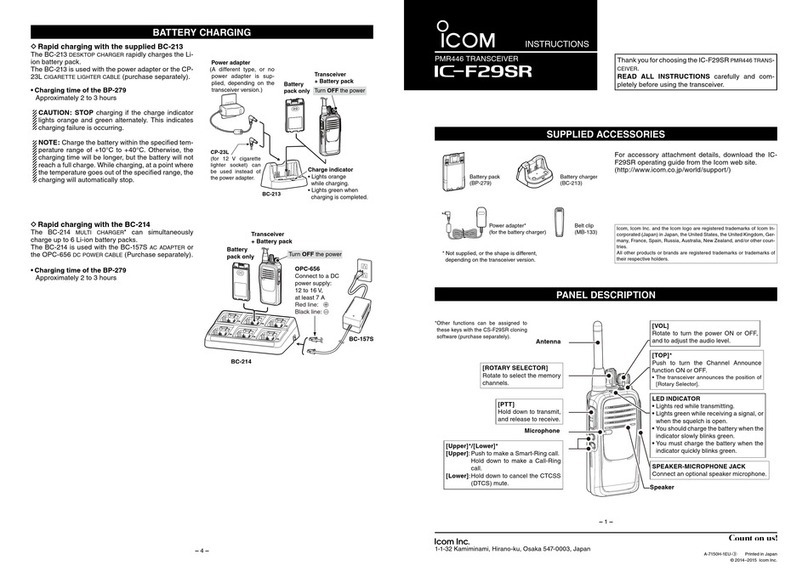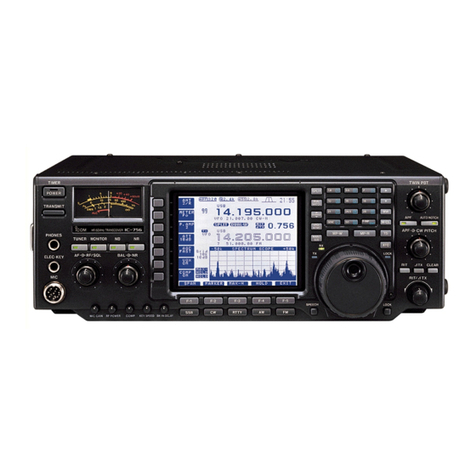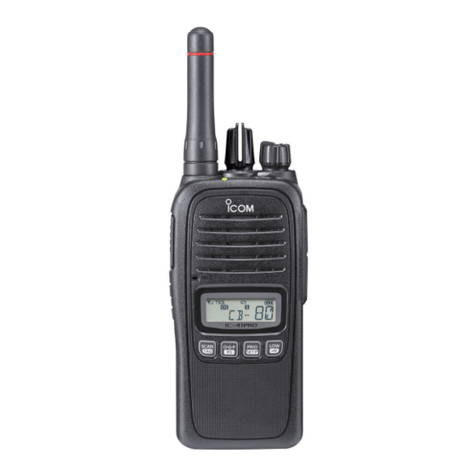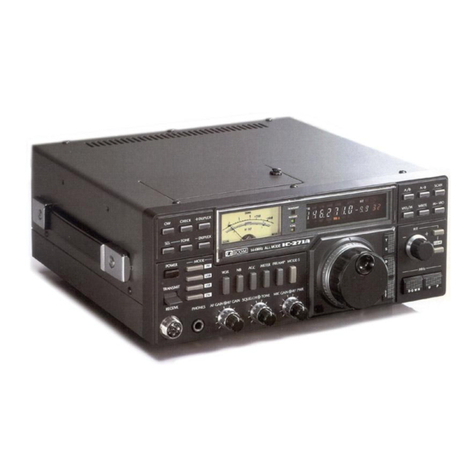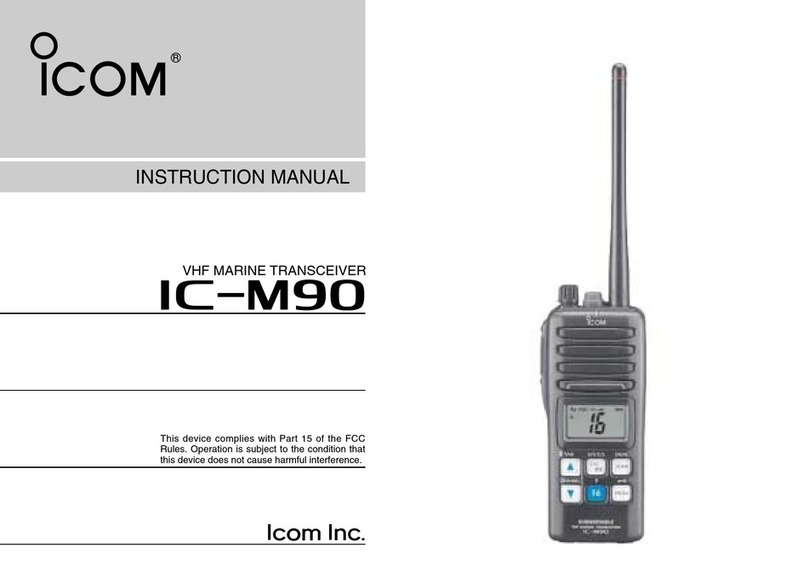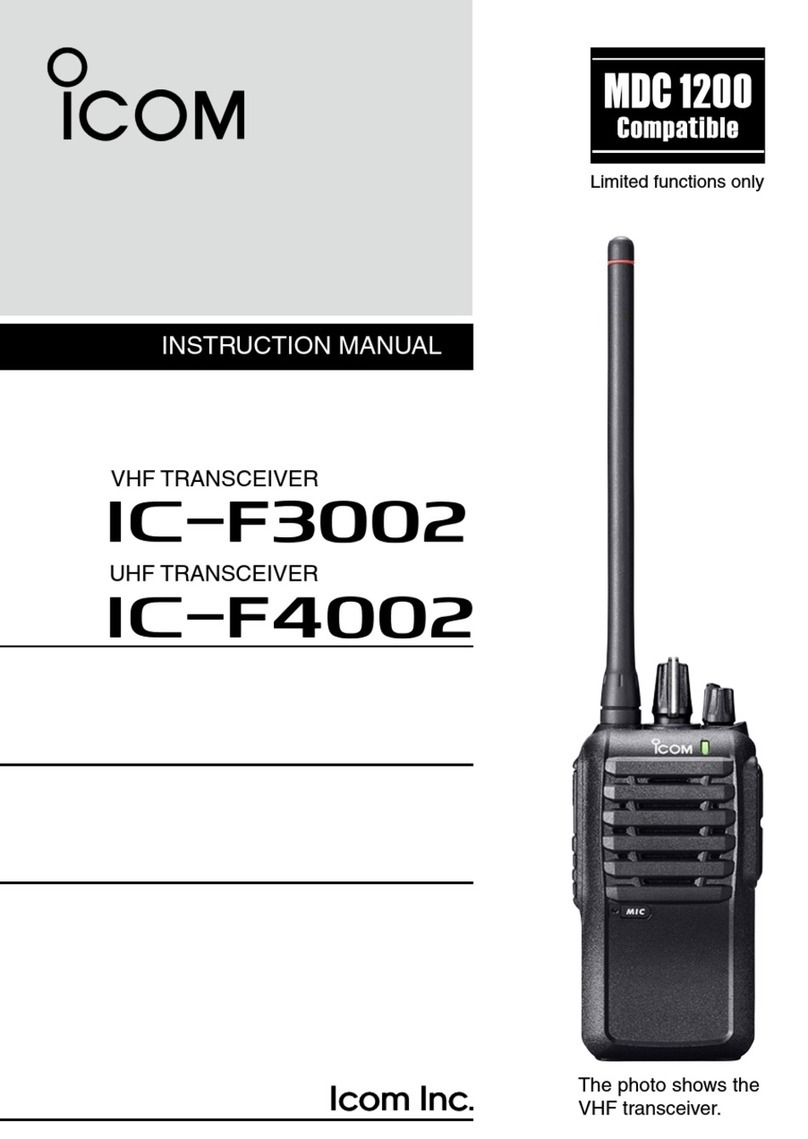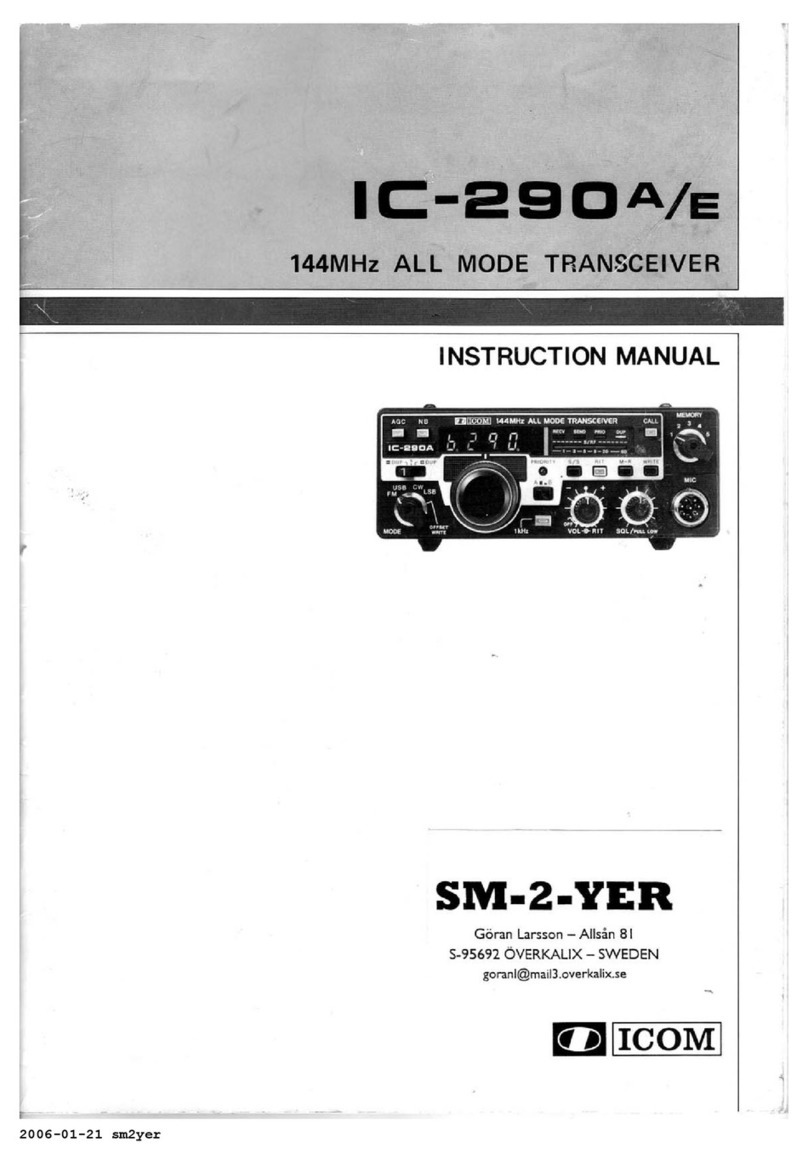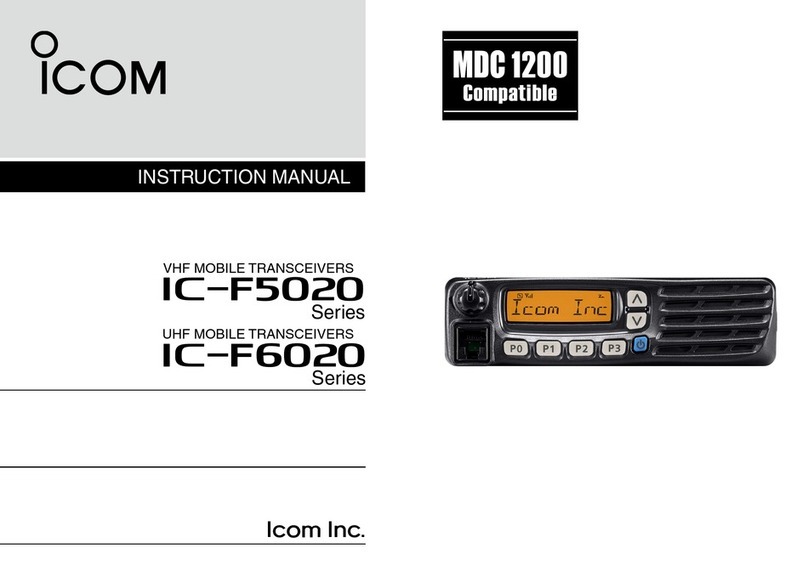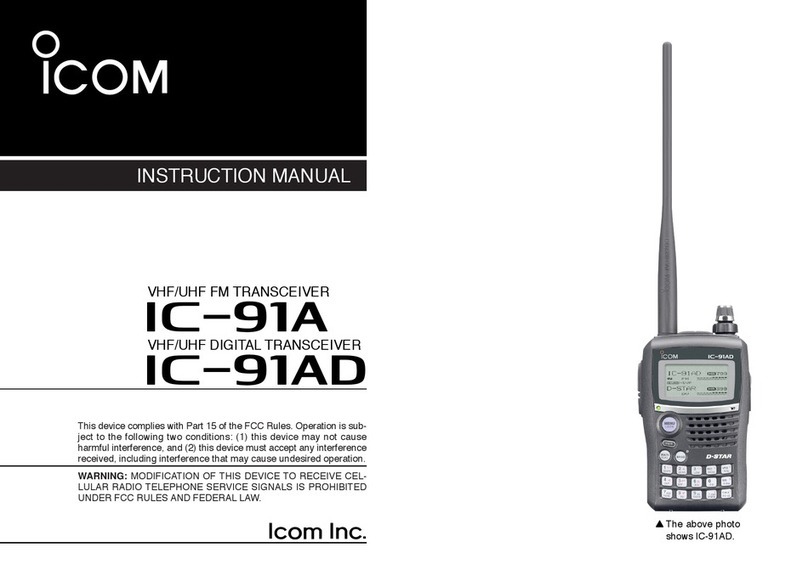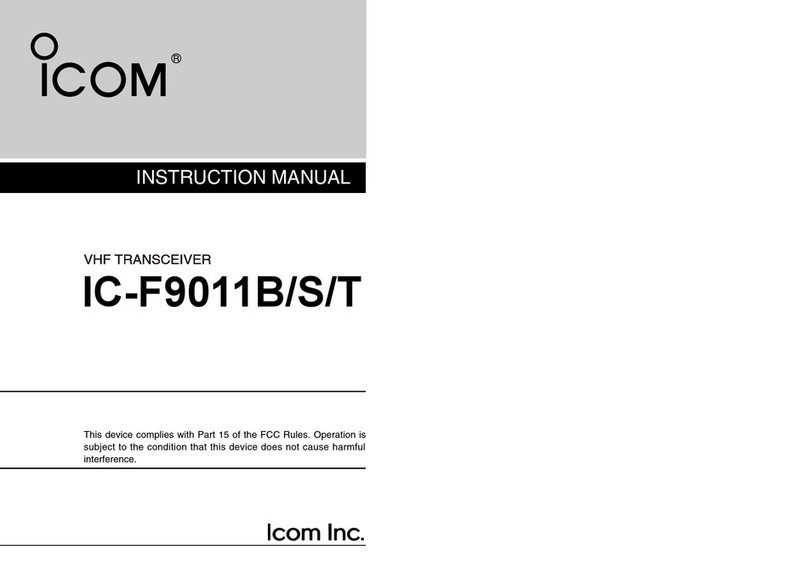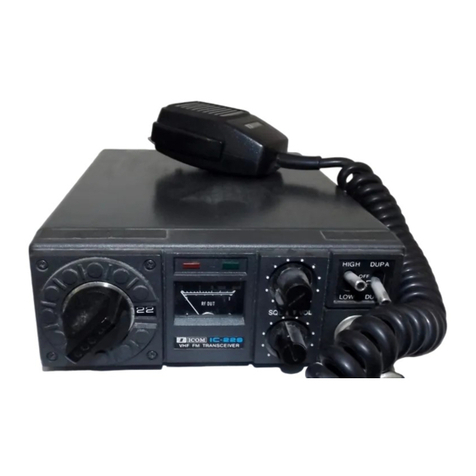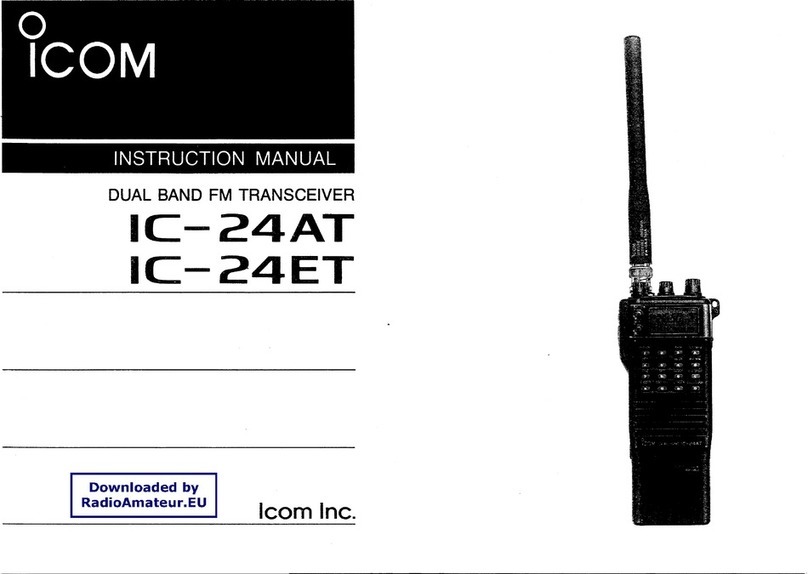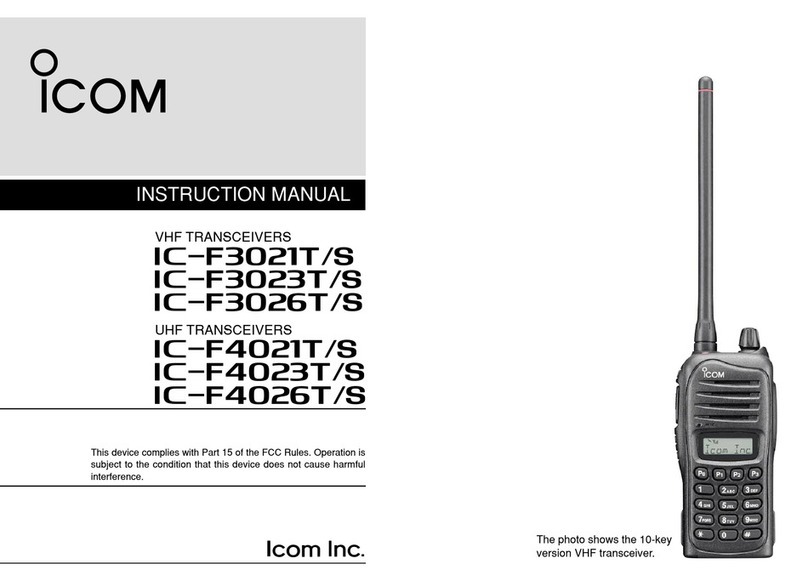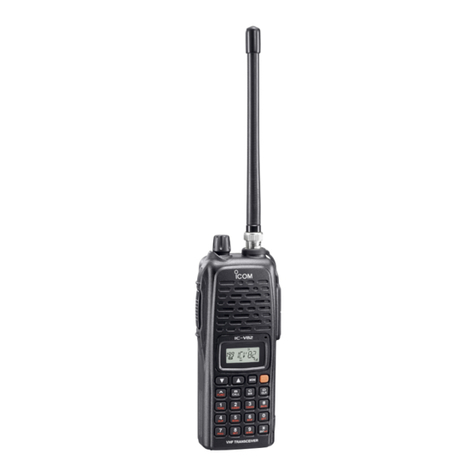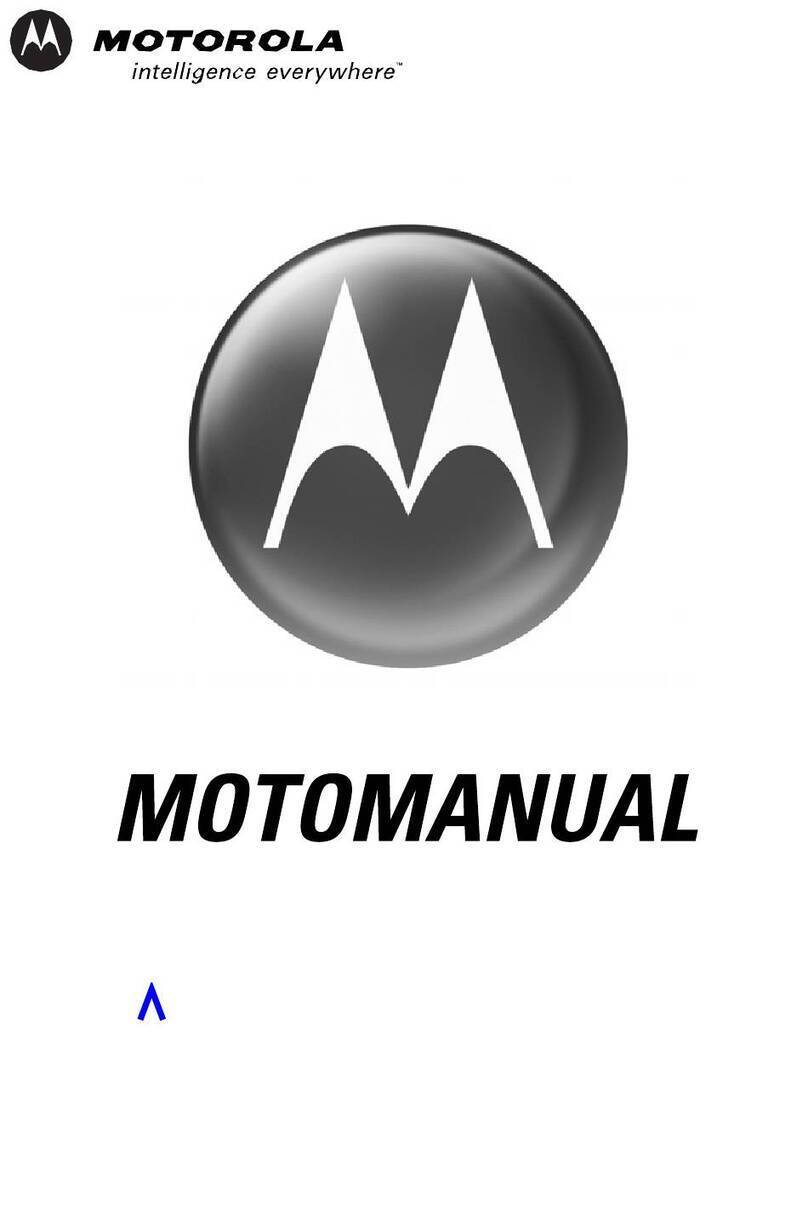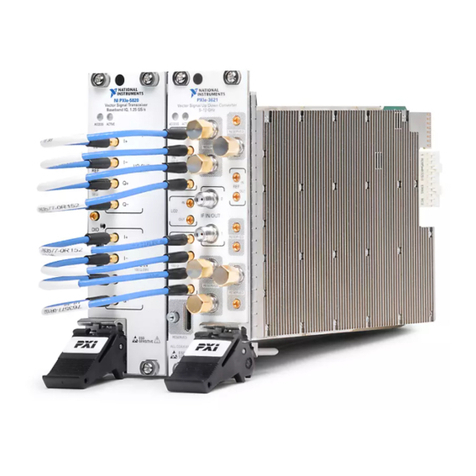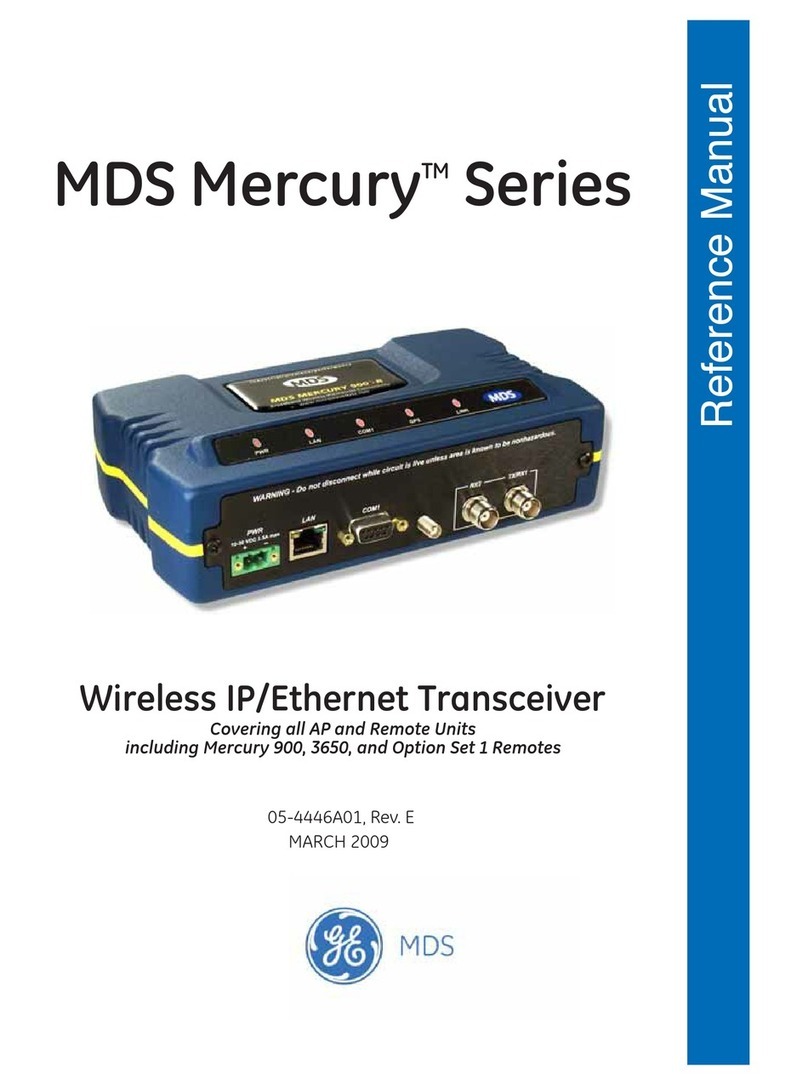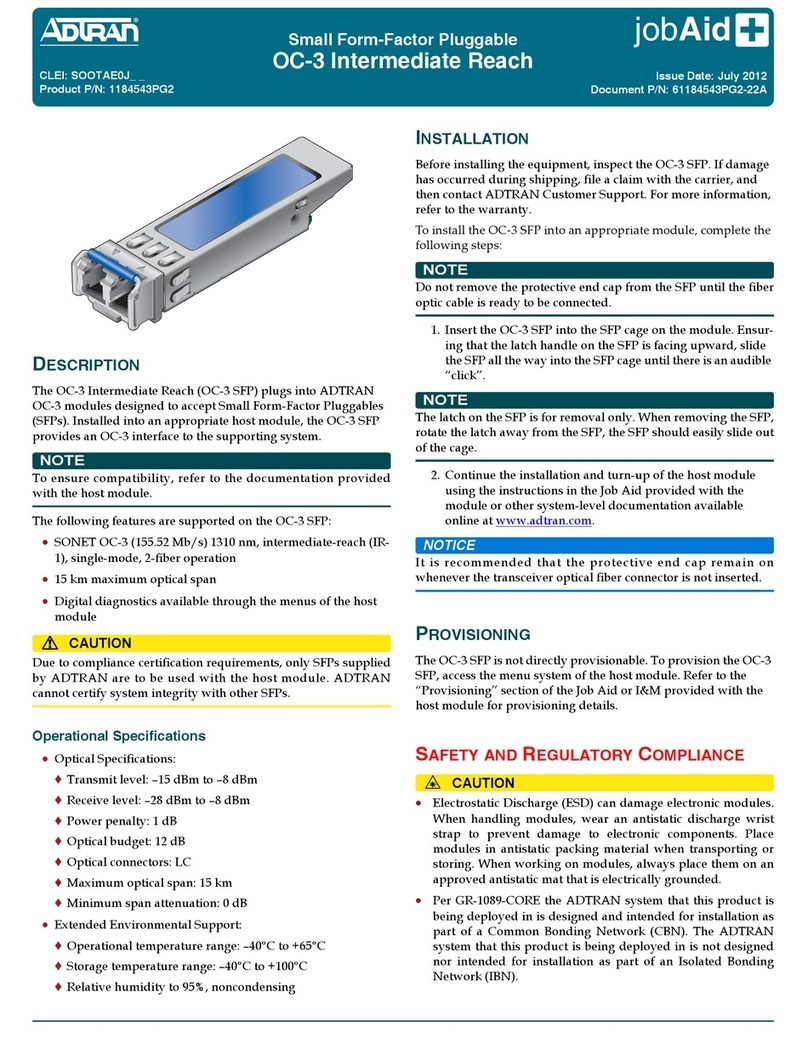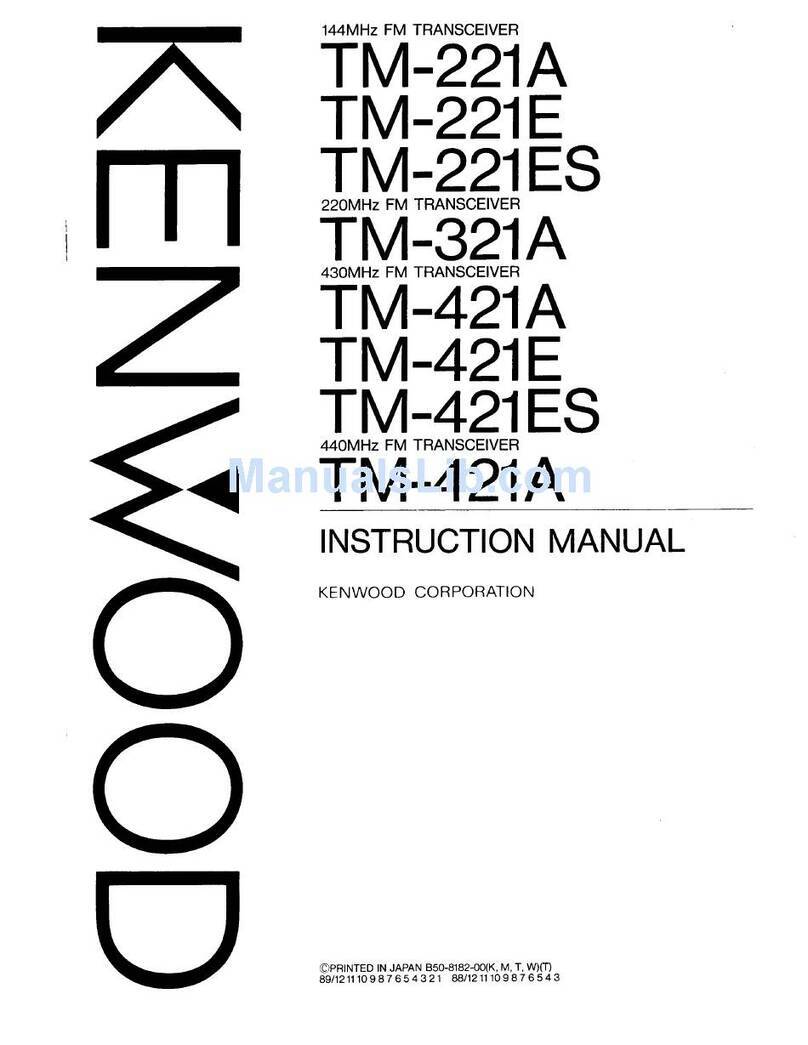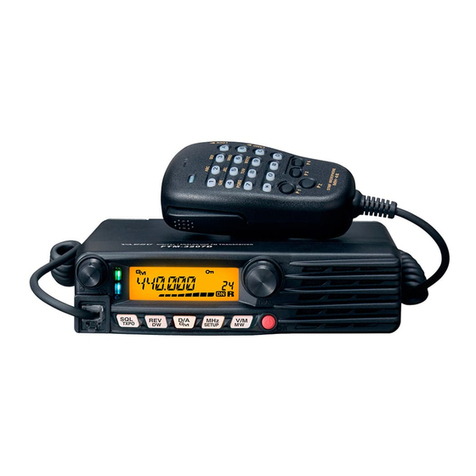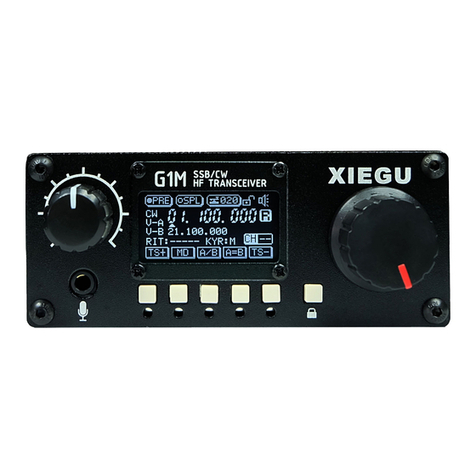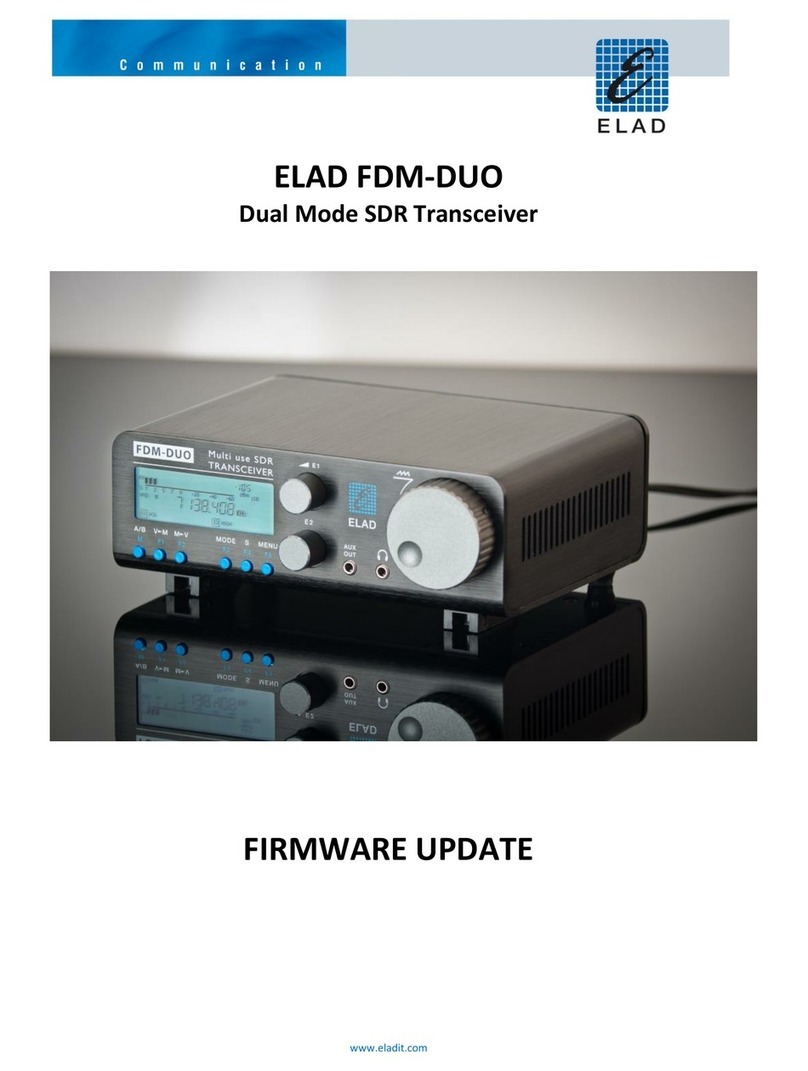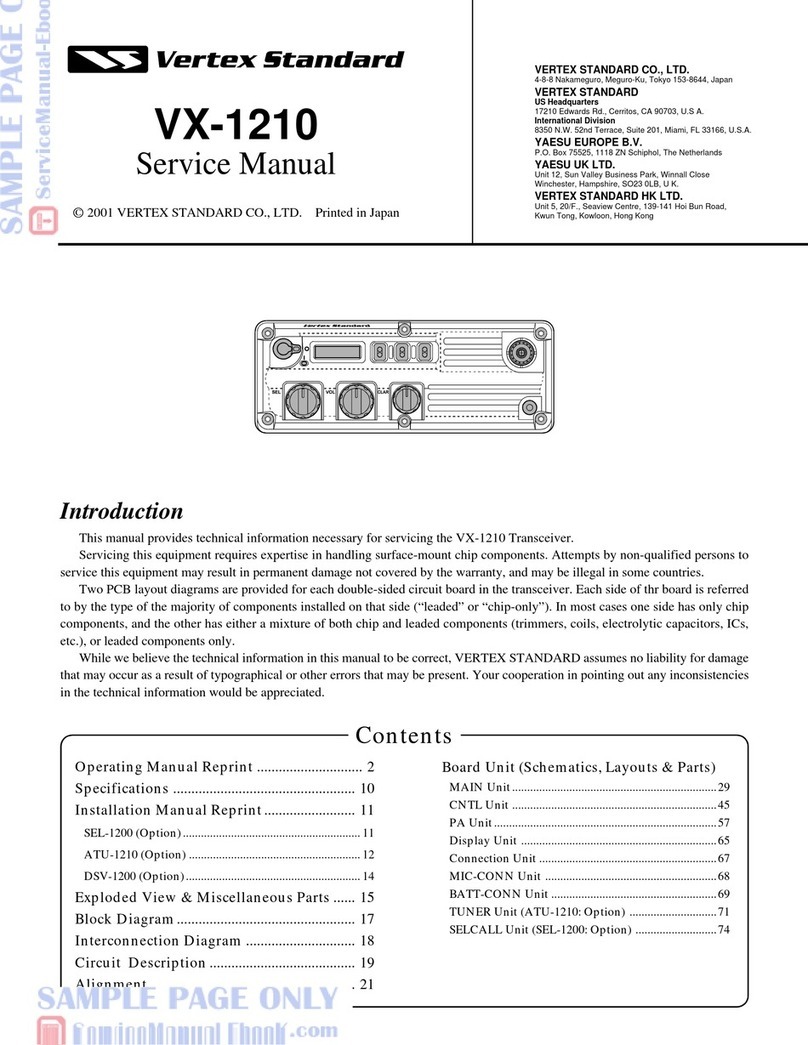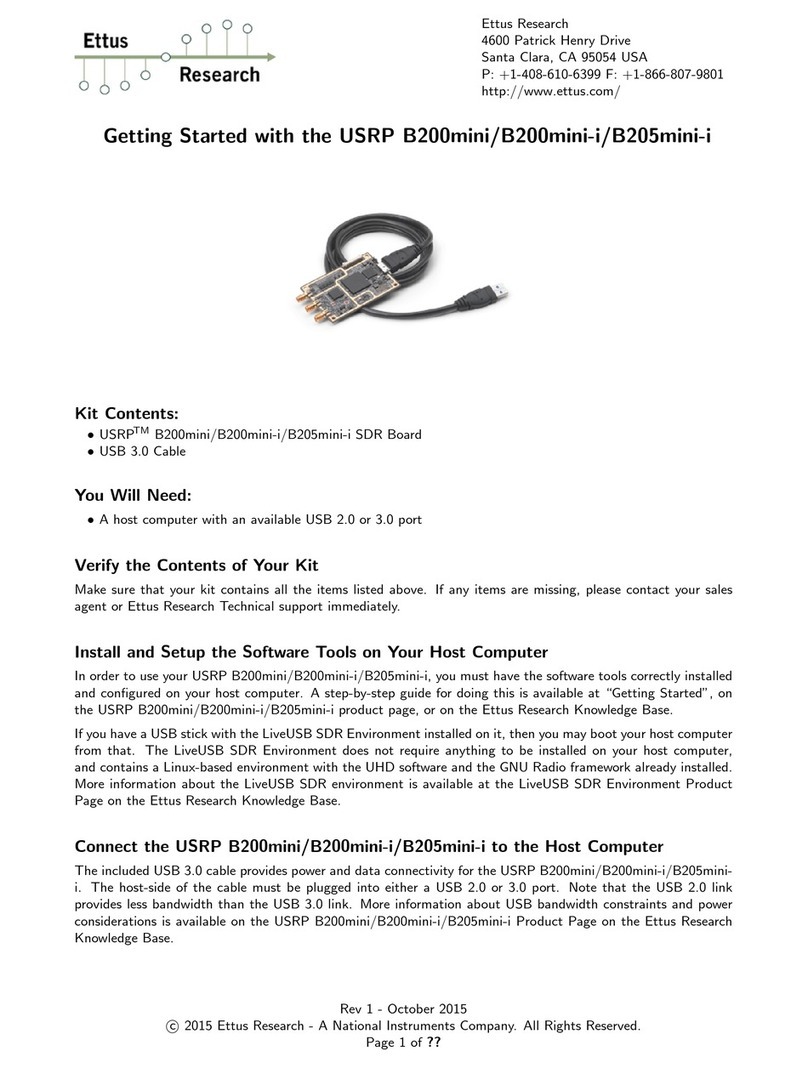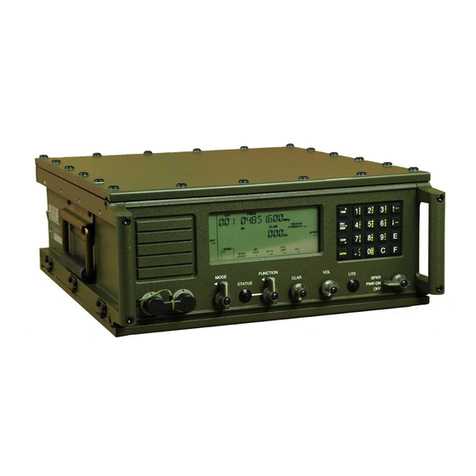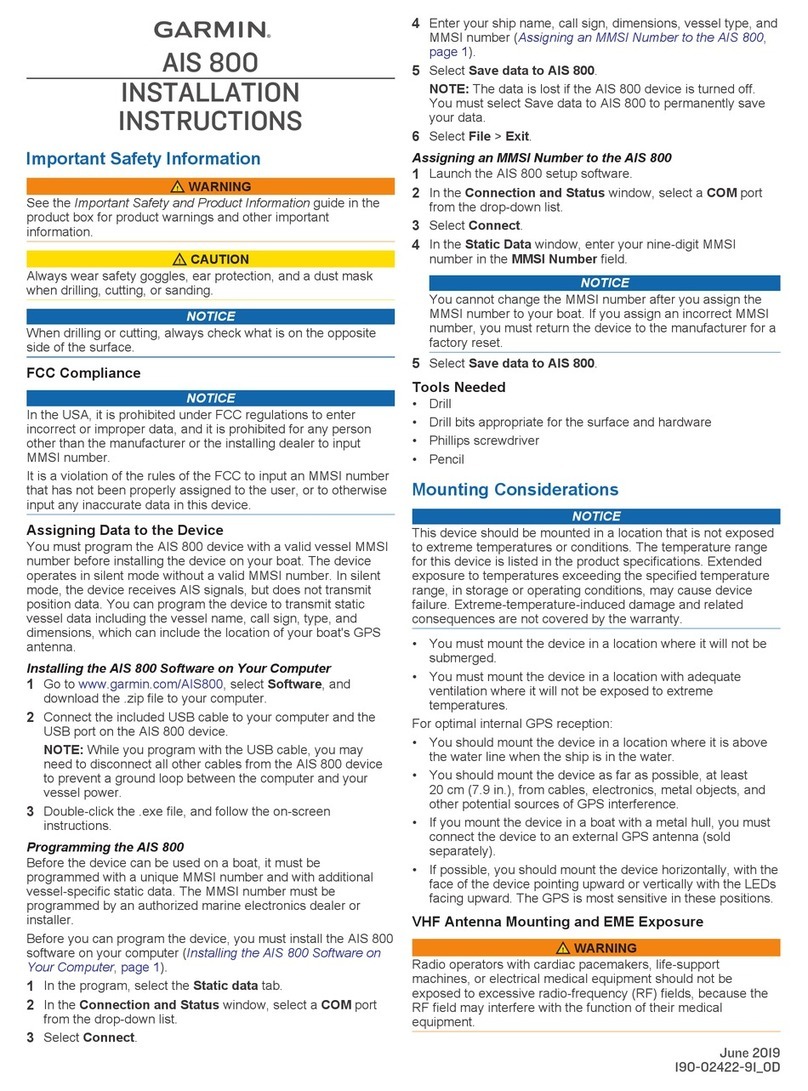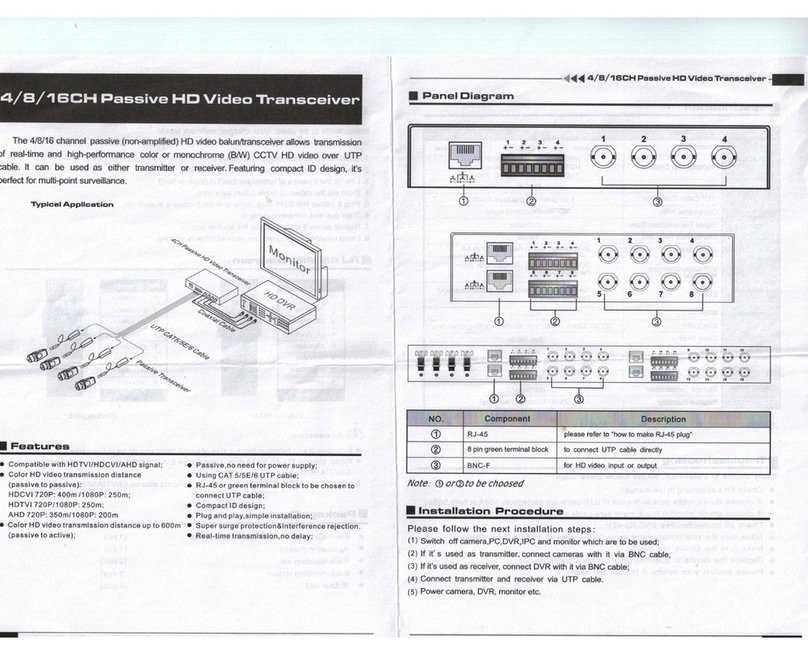Icom IC-F3230D User manual

INSTRUCTION MANUAL
This device complies with Part 15 of the FCC Rules. Opera-
tion is subject to the condition that this device does not cause
harmful interference.
iF3230D Series
VHF DIGITAL TRANSCEIVERS
iF4230D Series
UHF DIGITAL TRANSCEIVERS
The photo shows the VHF
transceiver (S type)

i
IMPORTANT
READ ALL INSTRUCTIONS carefully and com-
pletely before using the transceiver.
SAVE THIS INSTRUCTION MANUAL — This
instruction manual contains important operating instructions
for the IC-F3230DT, IC-F3230DS VHF DIGITAL TRANS-
CEIVERS and the IC-F4230DT, IC-F4230DS UHF DIGITAL
TRANSCEIVERS.
See the operating guide for details of IDAS (ICOM Digital
Advanced System) system operations. Ask your dealer for
details.
EXPLICIT DEFINITIONS
WORD DEFINITION
RDANGER! Personal death, serious injury or an ex-
plosion may occur.
RWARNING! Personal injury, fire hazard or electric
shock may occur.
CAUTION Equipment damage may occur.
NOTE If disregarded, inconvenience only. No risk
of personal injury, fire or electric shock.
VOICE CODING TECHNOLOGY
The AMBE+2™ voice coding Technology embodied in this
product is protected by intellectual property rights including
patent rights, copyrights and trade secrets of Digital Voice
Systems, Inc. This voice coding Technology is licensed solely
for use within this Communications Equipment. The user of
this Technology is explicitly prohibited from attempting to ex-
tract, remove, decompile, reverse engineer, or disassemble
the Object Code, or in any other way convert the Object Code
into a human-readable form. U.S. Patent Nos.
#5,870,405, #5,826,222, #5,754,974, #5,701,390, #5,715,365,
#5,649,050, #5,630,011, #5,581,656, #5,517,511, #5,491,772,
#5,247,579, #5,226,084 and #5,195,166.
Icom, Icom Inc. and the Icom logo are registered trademarks of Icom Incor-
porated (Japan) in Japan, the United States, the United Kingdom, Germany,
France, Spain, Russia, Australia, New Zealand, and/or other countries.

ii
RDANGER! NEVER short terminals of the battery
pack. Also, current may flow into nearby metal objects such
as a key, so be careful when placing the battery packs (or the
transceiver) in handbags, etc. Simply carrying with or plac-
ing near metal objects such as a key, etc. may cause short-
ing. This may damage not only the battery pack, but also the
transceiver.
RDANGER! Use and charge only specified Icom bat-
tery packs with Icom transceivers or Icom chargers. Only
Icom battery packs are tested and approved for use with Icom
transceivers or charged with Icom chargers. Using third-party
or counterfeit battery packs or chargers may cause smoke,
fire, or cause the battery to burst.
RWARNING! NEVER hold the transceiver so that
the antenna is very close to, or touching exposed parts of
the body, especially the face or eyes, while transmitting. The
transceiver will perform best if the microphone is 5 to 10 cm (2
to 4 inches) away from the lips and the transceiver is vertical.
RWARNING! NEVER operate the transceiver with
a headset or other audio accessories at high volume levels.
The continuous high volume operation may cause a ringing
in your ears. If you experience the ringing, reduce the volume
level or discontinue use.
RWARNING! NEVER operate the transceiver while
driving a vehicle. Safe driving requires your full attention—
anything less may result in an accident.
CAUTION: MAKE SURE the flexible antenna, bat-
tery pack and jack cover are securely attached to the trans-
ceiver, and that the antenna and battery pack are dry before
attachment. Exposing the inside of the transceiver to dust or
water will result in serious damage to the transceiver.
DO NOT operate the transceiver near unshielded electri-
cal blasting caps or in an explosive atmosphere.
DO NOT push [PTT] when you do not actually intend to
transmit.
DO NOT operate or place the transceiver in direct sunlight
or in areas with temperatures below –30°C (–22°F) or above
+60°C (+140°F).
DO NOT modify the transceiver. The specifications may
change and then not comply with the requirements of a corre-
sponded regulation. The transceiver warranty does not cover
any problems caused by unauthorized modification.
DO NOT use harsh solvents such as benzine or alcohol
when cleaning, as they will damage the transceiver surfaces.
PRECAUTIONS

iii
FCC INFORMATION
• FOR CLASS A UNINTENTIONAL RADIATORS:
This equipment has been tested and found to comply with the
limits for a Class A digital device, pursuant to part 15 of the
FCC Rules. These limits are designed to provide reasonable
protection against harmful interference when the equipment
is operated in a commercial environment. This equipment
generates, uses, and can radiate radio frequency energy
and, if not installed and used in accordance with the instruc-
tion manual, may cause harmful interference to radio commu-
nications. Operation of this equipment in a residential area is
likely to cause harmful interference in which case the user will
be required to correct the interference at his own expense.
CAUTION: Changes or modifications to this transceiver, not
expressly approved by Icom Inc., could void your authority to
operate this transceiver under FCC regulations.
PRECAUTIONS (Continued)
BE CAREFUL! The transceiver will become hot when
operating it continuously for long periods of time.
BE CAREFUL! The transceiver meet IP67* require-
ments for dust-tight and waterproof protection. However,
once the transceiver has been dropped, dust-tight and water-
proof protection cannot be guaranteed because of possible
damage to the transceiver’s case or the waterproof seal.
* Only when the jack cover or the optional HM-168LWP is
attached.
Even when the transceiver power is OFF, a slight current still
flows in the circuits. Remove the battery pack or batteries
from the transceiver when not using it for a long time. Other-
wise, the installed battery pack or batteries will become ex-
hausted, and will need to be recharged or replaced.
MAKE SURE
to turn OFF the transceiver power before
connecting the supplied/optional equipment.

iv
1
2
3
4
5
6
7
8
9
10
11
12
13
14
15
16
TABLE OF CONTENTS
IMPORTANT..........................................................................i
EXPLICIT DEFINITIONS....................................................... i
VOICE CODING TECHNOLOGY .......................................... i
PRECAUTIONS.................................................................... ii
FCC INFORMATION ........................................................... iii
TABLE OF CONTENTS....................................................... iv
1 ACCESSORIES ...........................................................1–2
■Supplied accessories...................................................1
■Accessory attachments................................................1
2 PANEL DESCRIPTION................................................3–7
■Front panel ...................................................................3
■Function display ...........................................................4
■Programmable function keys........................................5
3 BASIC OPERATION..................................................8–10
■Turning power ON........................................................8
■Channel selection ........................................................9
■User set mode..............................................................9
■Priority A channel selection..........................................9
■Receiving and transmitting.........................................10
4 BATTERY CHARGING ............................................11–16
■Caution.......................................................................11
■Battery chargers.........................................................13
5 BATTERY CASE......................................................17–19
■BP-240 optional battery case.....................................17
■BP-261 optional battery case.....................................18
6 SPEAKER MICROPHONE............................................20
■Optional HM-168LWP description..............................20
■Attaching....................................................................20
7 OPTIONAL SWIVEL BELT CLIP ............................21–22
■MB-93 contents..........................................................21
■Attaching....................................................................21
■Detaching...................................................................22
8 OPTIONS.................................................................23–24
9 SAFETY TRAINING INFORMATION.......................25–26

1
1ACCESSORIES
■Supplied accessories
NOTE: Some accessories are not supplied, depending on
the transceiver version.
Flexible antenna*
(This illustration is of the VHF type.)
Battery pack
Belt clip Power adapter*
(for the battery charger)
Battery charger*
*Not supplied, or the shape is different, depending on the trans-
ceiver version.
■Accessory attachments
DFlexible antenna
Connect the supplied flexible antenna to
the antenna connector.
CAUTION:
• NEVER carry the transceiver by
holding only the antenna.
• DO NOT connect an antenna other
than those listed on page 24.
• Transmitting without an antenna may
damage the transceiver.
DBattery pack
To attach the battery pack:
Slide the battery pack in the direction of the arrow (q) until
the battery release button makes a ‘click’ sound.
NOTE: Push on the bottom of the pack to make sure the
release button is firmly locked.
To release the battery pack:
Slide the battery release button in the direction of the arrow
(w) as shown below. The battery pack is then released.
NEVER release or attach the battery pack when the trans-
ceiver is wet or soiled. This may result water or dust getting
into the transceiver/battery pack and may result in the
transceiver being damaged.
q
w
Battery release b
utton
NOTE: Keep battery terminals clean. It’s a good idea to
occasionally clean them.

2
1
ACCESSORIES
1
2
3
4
5
6
7
8
9
10
11
12
13
14
15
16
DBelt clip
To attach the belt clip:
qRemove the battery pack if it is attached.
w Slide the belt clip in the direction of the arrow until the belt
clip is locked and makes a ‘click’ sound.
To detach the belt clip:
qRemove the battery pack if it is attached.
wPinch the clip (q), and slide the belt clip in the direction of
the arrow (w).
q
w
DJack cover
To attach the jack cover:
qAttach the jack cover to the [MIC/SP] jack. (q)
wTighten the screws. (w)
w
[MIC/SP] jack
Jack cover
q
CAUTION:
• Attach the jack cover when the optional equipment is not
used.
• Use only the supplied screws.
To detach the jack cover:
qUnscrew the screws using a phillips
screwdriver. (q)
wDetach the jack cover to connect the
optional equipment. (w)q
qw

3
2PANEL DESCRIPTION
■Front panel
q
w
r
e
o
u
y
Microphone
Speaker
t
i
qANTENNA CONNECTOR
Connects the supplied antenna.
wDEALER-PROGRAMMABLE KEY [Emer]
A desired function can be programmed by your dealer. (p. 5)
eDEALER-PROGRAMMABLE KEY [Side1]
A desired function can be programmed by your dealer. (p. 5)
rPTT SWITCH [PTT]
Hold down to transmit, release to receive.
tDEALER-PROGRAMMABLE KEYS [Side2]/[Side3]
Desired functions can be independently programmed by
your dealer.
(p. 5)
yDEALER-PROGRAMMABLE KEYS [P0] to [P3]
Desired functions can be independently programmed by
your dealer.
(p. 5)
uFUNCTION DISPLAY
(p. 4)
Displays a variety of information such as an operating
channel number, channel name, User Set mode contents,
and so on.
iEXTERNAL MICROPHONE/SPEAKER JACK
Connect an optional equipment.
NOTE: Connect or disconnect the optional equipment
after the transceiver is turned OFF.
Jack cover
NOTE: Attach the jack
cover when optional
equipment is not used.
See (p. 2) for details.
oVOLUME CONTROL [VOL]
Rotate to turn the power ON or OFF and to adjust the au-
dio level.

4
2
PANEL DESCRIPTION
1
2
3
4
5
6
7
8
9
10
11
12
13
14
15
16
■Function display
yq iutrew
o
!0
qTRANSMIT ICON
Appears while transmitting.
wBUSY ICON
Appears while the channel is busy (receiving).
eSIGNAL STRENGTH ICON
Shows the relative receive signal strength level.
Weak
Receive Signal level
Strong
About “ ” icon for the Trunking mode
➥Disappears while in a no service area.
➥Blinks while registering to a repeater.
➥Appears when registration is completed.
rLOW POWER ICON
Appears when low output power is selected.
• When the battery power decreases to a specified level,
low power is automatically selected.
tAUDIBLE ICON
➥In the analog mode, appears when the CTCSS (DTCS)
squelch mute is released while holding down [Monitor].
➥In the digital mode, appears while holding down [Moni-
tor].
yENCRYPTION ICON
In the digital mode, appears when the encryption function
is activated.
uBELL ICON
In the digital mode, appears/blinks when an SDM (Short
Data Message), Status Call or Call Alert is received, de-
pending on the preprogramming.
iKEY LOCK ICON
Appears when the Key lock function is ON.
oBATTERY ICON
Appears or blinks when the battery power decreases to a
specified level.
!0 ALPHANUMERIC DISPLAY
Displays an operating channel number, channel name,
User Set mode contents, and so on.

5
2PANEL DESCRIPTION
■Programmable function keys
The following functions can be assigned to [Emer],[Side1],
[Side2], [Side3], [P0], [P1], [P2] and [P3] programmable
function keys.
Consult your Icom dealer or system operator for details con-
cerning your transceiver’s programming.
CH UP AND DOWN
As described in the following topics, after pushing a pro-
grammed key, push [CH Up] or [CH Down] to select an op-
tion, setting, and so on.
ZONE
Push this key, then select the desired zone using [CH Up]/
[CH Down].
What is a “zone”?— Certain channels are grouped to-
gether and assigned to a zone, according to their intended
use. For example, ‘Staff A’ and ‘Staff B’ are assigned to a
“Business” zone, and ‘John’ and ‘Cindy’ are assigned to a
“Private” zone.
SCAN START/STOP
➥Push to start and cancel a scan.
• When a scan is started with the Power ON Scan or Automatic
scan function, push this key to cancel it. The cancelled scan re-
sumes after a preprogrammed time period.
➥ Hold down this key for 1 second to display the scan group,
then push [CH Up] or [CH Down] to select the desired
group.
SCAN ADD/DEL (TAG)
➥Push to add the channel to, or delete it from, the current
scan group.
1. Push to display the scan group, then push [CH Up] or [CH Down]
to select the desired one.
2. Push to add the channel to, or delete it from, the selected scan
group.
3. Hold down for 1 second to exit the scan list selection mode.
➥While a scan is paused on a non-priority channel, push this
key to delete the selected channel from the scan group.
Depending on the setting, the cleared channel may be
automatically added to the scan group again after the
scan is cancelled.

6
2
PANEL DESCRIPTION
2
PRIORITY A CHANNEL, PRIORITY B CHANNEL
Push to select the Priority A or Priority B channel.
PRIORITY A CHANNEL (REWRITE),
PRIORITY B CHANNEL (REWRITE)
➥Push to select the Priority A or Priority B channel.
➥Hold down [Prio A (Rewrite)] or [Prio B (Rewrite)] for
1 second to assign the operating channel to Priority A or
Priority B channel, respectively.
MEMORY CHANNELS 1, 2, 3, 4
Push to directly select memory channel 1, 2, 3 or 4, if pro-
grammed.
Consult your dealer for details.
MONITOR
Push to turn the CTCSS (DTCS) squelch mute ON or OFF.
LIGHT
Push to turn ON the backlight for about 5 seconds, when the
backlight function is set to “OFF” in the User Set mode.
LOCK
➥Hold down this key until “LOCK ON” is displayed to elec-
tronically lock all programmable keys except the following:
[Moni], [Lock], [Emergency]*, [Surveillance], [Siren], [Lone
Worker]*, [Light] and [Shift].
*For digital operation. See the operating guide for details
➥To turn OFF the Key Lock function, hold down this key until
“LOCK OFF” is displayed.
HIGH/LOW
Push to select the transmit output power temporarily or per-
manently, depending on the preprogramming.
• Ask your dealer for the output power level for each selection.
TALK AROUND
Push to turn the Talk Around function ON or OFF.
• The Talk Around function equalizes the transmit frequency to the
receive frequency for transceiver-to-transceiver communication.
WIDE/NARROW
Push to toggle the IF bandwidth between wide and narrow.
SURVEILLANCE
Push to turn the surveillance function ON or OFF.
When this function is turned ON and a signal is received, the
beep is not heard and the LED does not light, even if a key
is pushed.

7
2PANEL DESCRIPTION
■Programmable function keys (Continued)
SIREN
Hold down for 1 second to sound the siren.
This function can be used for situations other than an emer-
gency alert, such as a security alarm for example.
• The siren can be stopped only by turning OFF the transceiver power.
USER SET MODE
➥Hold down for 1 second to enter the User Set mode.
• While in the User Set mode, push this key to select an item*, and
change the value or setting by pushing [CH Up] or [CH Down].
*Selectable items may differ, depending on the preprogram-
ming.
➥Hold down this key for 1 second again to exit the User Set
mode.
ANNOUNCE
Push to turn the Channel Announce function ON or OFF.
When this function is turned ON, the transceiver announces
the channel number when it is selected.
RESET
➥Push to return to the normal operating mode.
➥While in the audible mode, push to return to the inaudible
mode.
NOTE: See the operating guide for the [Reset] key opera-
tion in the digital mode.
SHIFT
Push to toggle the Normal mode key functions and the Shift
mode key functions.
• When the Shift mode is selected, the display briefly shows “SHIFT
ON.” When the Normal mode is selected, the display briefly shows
“SHIFT OFF.”

8
3
BASIC OPERATION
1
2
3
4
5
6
7
8
9
10
11
12
13
14
15
16
■Turning power ON
Prior to using the transceiver for the first time, the battery
pack must be fully charged for optimum life and operation.
(p. 12)
qRotate [VOL] to turn ON the power.
w If the transceiver is programmed for a start up password,
input the digit codes as directed by your dealer.
• The 10-keypad may be used for password input, depending on
the transceiver’s version:
• The keys in the table below can be used for password input.
• The transceiver detects numbers in the same block as identical.
Therefore “01234” and “56789” are the same.
KEY
NUMBER 0
5
4
9
3
8
2
7
1
6
[Side3]
[P0]/[P1]/
[P2]/[P3]
Side3
[VOL]
e When the “PASSWORD” indication does not clear after in-
putting 4 digits, the input code number may be incorrect.
Turn the power off and start over in this case.
DBattery type selection
The battery type must be selected according to the attached
battery type when turning ON the transceiver.
Ask your dealer for details.
qTurn OFF the power.
wWhile pushing and holding [Emer] and [PTT], turn ON
the power by rotating [VOL] to toggle the attached battery
type.
• After the display appears, release [Emer] and [PTT].
• “DRY BATT” is displayed for about 3 seconds then “L” appears
when the battery case use is selected. In this case, the transmit
output power is low.
• “LI-ION” is displayed for about 3 seconds when the Lithium-ion
battery use is selected.
[VOL]
[PTT]
[Emer]
Dry battery mode
Appears

9
3BASIC OPERATION
■Channel selection
Several types of channel selections are available. Methods
may differ, depending on your system set up.
NON-ZONE TYPE:
To select the desired operating channel:
➥Push [CH Up] or [CH Down].
➥Push one of [MR-CH 1] to [MR-CH 4].
➥Push one of these keys, [Prio A], [Prio B], [Prio A (Re-
write)] or [Prio B (Rewrite)].
ZONE TYPE:
To select the desired operating channel:
➥Push [Zone], then push [CH Up] or [CH Down].
VOTING OPERATION:
The transceiver automatically starts scanning when a zone,
specified for the voting operation, is selected.
The voting scan detects the S-meter of the repeater and au-
tomatically selects the strongest station.
AUTOMATIC SCAN TYPE:
Channel setting is not necessary for this type. When turning
ON the power, the transceiver automatically starts scanning.
Scanning stops when a signal is received.
■User set mode
The User Set mode allows you to set seldom-changed set-
tings. If the transceiver has [User Set Mode] assigned to it,
you can “customize” the transceiver operation to suit your
preferences and operating style.
Entering the User Set mode:
qHold down [User Set Mode] for 1 second to enter the User
Set mode.
wPush [User Set Mode] several times to select the appro-
priate item. Then push [CH Up] or [CH Down] to set the
desired level or condition.
• Selectable Set mode items are Backlight, Beep ON/OFF, Beep
Level, Ringer Level, SQL Level, AF Min Level, Mic Gain, Battery
Voltage, Signal Moni, Lone Worker and System Info.
eHold down [User Set Mode] for 1 second again to exit the
User Set mode.
■Priority A channel selection
When one of the following operations is performed, the trans-
ceiver automatically selects Priority A channel.
• Turning ON the power
Priority A channel is selected each time the transceiver’s
power is turned ON.
• Auto Reset
Priority A channel is selected when the Auto Reset timer
ends.
• OFF hook
Priority A channel is selected when you take the micro-
phone OFF hook.

10
3
BASIC OPERATION
3
■Receiving and transmitting
CAUTION: Transmitting without an antenna may damage
the transceiver. See page 1 for accessory attachments.
Receiving:
qRotate [VOL] to turn ON the power.
wPush [CH Up] or [CH Down] to sequentially select the con-
ventional system channel.
e When receiving a call, adjust the audio output level to a
comfortable listening level.
Transmitting:
Wait for the channel to become clear to avoid interference.
qWhile pushing and holding [PTT], speak into the micro-
phone at a normal voice level.
wRelease [PTT] to return to receive.
IMPORTANT: To maximize the readability of your signal;
1. Pause briefly after pushing [PTT].
2. Hold the microphone 5 to 10 cm (2 to 4 inches) from
your mouth, then speak at a normal voice level.
DTransmitting notes
• Transmit inhibit function
The transceiver has several inhibit functions which restrict
transmission under the following conditions:
- The channel is busy. However, depending on the pre-
programmed settings, you can transmit when the call
includes an unmatching (or matching) CTCSS (DTCS),
RAN code*, or Individual or Talkgroup ID*.
* Digital operation only
- The selected channel is a ‘receive only’ channel.
• Time-out timer
If continuous transmission exceeds the preprogrammed
time-out timer limit, the transmission is cut off.
• Penalty timer
After the transmission is cut off by the time-out timer, trans-
mission is further inhibited for the preprogrammed penalty
timer period.

11
4BATTERY CHARGING
■Caution
• Misuse of Lithium-ion batteries may result in the following
hazards: smoke, fire, or the battery may rupture. Misuse
can also cause damage to the battery or degradation of
battery performance.
• Prior to using the battery pack for the first time, or after
not using it for a long time, you must fully charge the pack.
Otherwise, the transceiver may not turn ON.
DBattery caution
RDANGER! DO NOT hammer or otherwise impact the bat-
tery. Do not use the battery if it has been severely impacted or
dropped, or if the battery has been subjected to heavy pres-
sure. Battery damage may not be visible on the outside of the
case. Even if the surface of the battery does not show cracks
or any other damage, the cells inside the battery may rupture
or catch fire.
RDANGER! NEVER use or leave battery packs in areas with
temperatures above +60˚C (+140˚F). High temperature build-
up in the battery, such as could occur near fires or stoves,
inside a sun heated car, or in direct sunlight may cause the
battery to rupture or catch fire. Excessive temperatures may
also degrade battery performance or shorten battery life.
RDANGER! DO NOT expose the battery to rain, snow, sea-
water, or any other liquids. Never charge or use a wet battery.
If the battery gets wet, be sure to wipe it dry before using.
RDANGER! NEVER incinerate used battery packs since in-
ternal battery gas may cause them to rupture, or may cause
an explosion.
RDANGER! NEVER solder the battery terminals or NEVER
modify the battery pack.This may cause heat generation, and
the battery may rupture, emit smoke or catch fire.
RDANGER! Use the battery only with the transceiver for
which it is specified. Never use a battery with any other equip-
ment, or for any purpose that is not specified in this instruc-
tion manual.
RDANGER! If fluid from inside the battery gets in your eyes,
blindness can result. Rinse your eyes with clean water, with-
out rubbing them, and see a doctor immediately.
RWARNING! Immediately stop using the battery if it emits
an abnormal odor, heats up, or is discolored or deformed. If
any of these conditions occur, contact your Icom dealer or
distributor.
RWARNING! Immediately wash, using clean water, any part
of the body that comes into contact with fluid from inside the
battery.
RWARNING! NEVER put the battery in a microwave oven,
high-pressure container, or in an induction heating cooker. This
could cause a fire, overheating, or cause the battery to rupture.

12
4
BATTERY CHARGING
1
2
3
4
5
6
7
8
9
10
11
12
13
14
15
16
CAUTION: Always use the battery within the specified tempera-
ture range, –20˚C to +60˚C (–4˚F to +140˚F). Using the battery
out of its specified temperature range will reduce the battery’s
performance and battery life.
CAUTION: Shorter battery life could occur if the battery is left
fully charged, completely discharged, or in an excessive temper-
ature environment (above +50˚C; +122˚F) for an extended period
of time. If the battery must be left unused for a long time, it must
be detached from the transceiver after discharging.You may use
the battery until the remaining capacity is about half, then keep
it safely in a cool dry place with the temperature range as below:
–20˚C to +50˚C (–4˚F to +122˚F) (within a month)
–20˚C to +35˚C (–4˚F to +95˚F) (within three months)
BE SURE to replace the battery pack with a new one approxi-
mately five years after purchasing, even if it still holds a charge.
The inside battery material will become weak after a period of
time, even with little use. The estimated number of charging and
discharging cycles is between 300 and 500, depending on the
type of operation. Even when the battery appears to be fully
charged, the operating time of the transceiver may become short
when:
• Approximately five years have passed since the battery was
manufactured.
• The battery has been repeatedly charged.
DCharging caution
RDANGER! NEVER charge the battery pack in areas with ex-
tremely high temperatures, such as near fires or stoves, inside a
sun heated car, or in direct sunlight. In such environments, the
safety/protection circuit in the battery will activate, causing the
battery to stop charging.
RWARNING! NEVER charge or leave the battery in the bat-
tery charger beyond the specified time for charging. If the battery
is not completely charged by the specified time, stop charging
and remove the battery from the battery charger. Continuing to
charge the battery beyond the specified time limit may cause a
fire, overheating, or the battery may rupture.
RWARNING! NEVER insert the transceiver (battery attached to
the transceiver) into the charger if it is wet or soiled. This could
corrode the battery charger terminals or damage the charger.
The charger is not waterproof.
CAUTION: NEVER charge the battery outside of the speci-
fied temperature range: BC-160/BC-171 (0˚C to +45˚C; +32˚F
to +113˚F). BC-119N/BC-121N/BC-197 (+10˚C to +40˚C; +50˚F
to +104˚F). Icom recommends charging the battery at +20˚C
(+68˚F). The battery may heat up or rupture if charged out of the
specified temperature range. Additionally, battery performance or
battery life may be reduced.

13
4BATTERY CHARGING
■Battery chargers
DRapid charging with the BC-160
The optional BC-160 rapidly charges the Li-ion battery pack.
• A power adapter (may be supplied with BC-160, depending
on the version) or the DC power cable (OPC-515L/CP-23L)
is additionally required.
Power adapter
(Not supplied with
some versions.)
Optional OPC-515L
(for 13.8 V power
source) or CP-23L
(for 12 V cigarette
lighter socket) can
be used instead of
the power adapter.
*
TransceiverBattery
pack Tu rn OFF the power
CAUTION: NEVER reverse the cable polarity
when connecting the OPC-515L to a power
source. This will ruin the battery charger.
White line: Black line:
*
DRegular charging with the BC-171
The optional BC-171 regularly charges the Li-ion battery
pack.
• A power adapter (may be supplied with BC-171, depending
on the version) or the DC power cable (OPC-515L/CP-23L)
is additionally required.
Po
wer adapter
(Not supplied with
some v
ersions.)
Optional OPC-515L
(for 13.8 V power
source) or CP-23L
(for 12 V cigarette
lighter socket) can
be used instead of
the power adapter.
*
TransceiverBattery
pack Tu rn OFF the powe
r
CAUTION: NEVER reverse the cable polarity
when connecting the OPC-515L to a power
source. This will ruin the battery charger.
White line: Black line:
*

14
4
BATTERY CHARGING
1
2
3
4
5
6
7
8
9
10
11
12
13
14
15
16
DAD-106 installation
The AD-106 charger adapter must be installed into the BC-
119N or BC-121N before battery charging.
➥Connect the AD-106 charger adapter and the BC-119N/
BC-121N as shown below, then install the AD-106 into the
holder space of the BC-119N or BC-121N with the sup-
plied screws.
Screws
supplied
with the
charger
adapter
AD-106
Connectors
Plugs
* This illustration is of the BC-119N.
DRapid charging with the BC-119N+AD-106
The optional BC-119N rapidly charges the Li-ion battery
pack. The following items are additionally required.
• AD-106 charger adapter
• A power adapter (may be supplied with the BC-119N, de-
pending on the version) or the DC power cable (OPC-515L/
CP-23L).
AD-106 charger
adapter is installed
in BC-119N.
Power adapter
(Not supplied with
some versions.)
Optional OPC-515L
(for 13.8 V power
source) or CP-23L
(for 12 V cigarette
lighter socket) can
be used instead of
the power adapter.
Transceiver
Battery
pack
Tu rn OFF the power
CAUTION: NEVER reverse the cable polarity
when connecting the OPC-515L to a power
source. This will ruin the battery charger.
White line: Black line:
*
*

15
4BATTERY CHARGING
DRapid charging with the BC-121N+AD-106
The optional BC-121N can simultaneously charge up to 6
Li-ion battery packs. The following items are additionally re-
quired.
• Six AD-106 charger adapters
•
An optional power adapter or the DC power cable (OPC-656)
Battery
pack
AD-106 charger
adapters are installed
in each slot.
Po
wer adapter
(Purchased
separately)
Transceiver
Tu rn OFF the power
OPC-656 *(DC power cable)
(Connect to a DC power supply;
12 to 16 V/at least 7 A)
CAUTION: NEVER reverse the cable polar
ity
when connecting the OPC-656 to a po
wer
source. This will ruin the battery charger.
Red line: Black line:
*
DRapid charging with the BC-197
The optional BC-197 can simultaneously charge up to 6 Li-ion
battery packs. The following items are additionally required.
•
An optional power adapter
(not supplied with some versions)
or the DC power cable (OPC-656)
Transceiver
Battery pack Tu rn OFF the power
Status indicator
(each indicator independently functions)
OPC-656 *(DC power cable)
Power adapter
(No power adapter is
supplied, depending
on the version.)
(Connect to a DC power supply;
12 to 16 V/at least 7 A)
CAUTION: NEVER reverse the cable polar
ity
when connecting the OPC-656 to a po
wer
source. This will ruin the battery charger.
Red line: Black line:
*
The charger adapters are in-
stalled in each slot.The shape
of charger adapter depends
on the version of the BC-197.
Other manuals for IC-F3230D
2
This manual suits for next models
2
Table of contents
Other Icom Transceiver manuals
